|
|
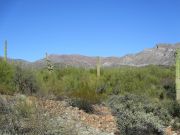
The highpoint is the leftmost of the three peaks seen on the distant ridge, as viewed from the access road
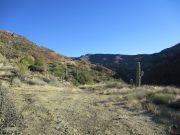
A typical view of the road hike into the canyon. The highpoint is not visible from within the canyon
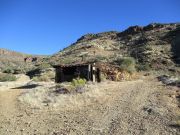
A shack!
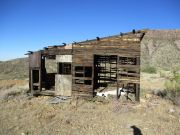
The shack in detail
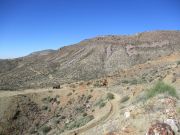
shack from above. A mine adit is seen to the right

Finally, the highpoint comes into view

The summit ahead, and a cliffy subpeak to get around
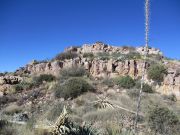
The cliffs on that subpeak
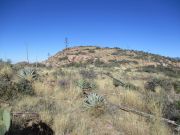
On the home stretch to the top
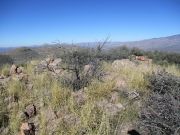
The summit. I felt the highest rock was the one at center-right, in front of the one with the rocks atop it
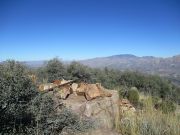
Pinal Peak, northeast
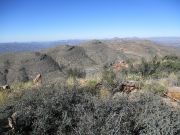
Tam O'Shanter Peak, northwest
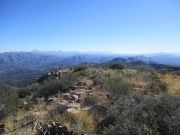
Mount Turnbull and other peaks, southeast
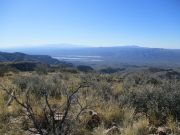
Black Mountain, and farther back to the left, the Rincon and Santa Catalina Mountains, plus some tailings ponds near Hayden
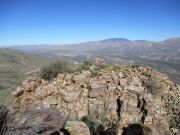
An interesting cairn atop a rock oucrop near the summit, but requiring some tricky downclimbing to access it
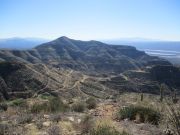
View of the shack from high above, plus the maze of roads in that area

View down the ascent canyon
All images
• • •

The Arizona
Mountains Gazetteer
Click to find out more!
|
|
|
Date: November 27, 2022
• Elevation: 4,676 feet
• Prominence: 1,033 feet
• Distance: 9 miles
• Time: 4 hours, 45 minutes
• Gain: 2,100 feet
• Conditions: Clear, cold at first, warmed nicely, no clouds
Arizona
•
Main
•
AZ P1K
•
PB
•
LoJ
Peak 4676 is the highest point of the southern half of the Dripping Springs Mountains, rising over the mining town of Hayden. The peak, which has no name, lies southeast of Tam O'Shanter Peak and northwest of Tornado Peak. The area below the peak was mined extensively, and is covered in roads and old adits. A slightly-rough dirt road leads north off of State Route AZ-177 a little west of Hayden, bumping its way about four miles to a big metal gate that spans the road. This is the de-facto trailhead, assuming you can get your vehicle to this point. If the gate is open, it's still wise to park below it to avoid being locked in.
Matthias hiked this peak earlier in the year. During our hikes in the Maricopa Mountains on Friday, I brought it up because I was interested in hiking it myself soon. With the beta provided by him, I put it on my agenda for today. The weather has been mild and gorgeous. It would be perfect conditions for hiking.
I was on the road at 6 a.m., timing my drive so that I was in the general Hayden area as the sun was rising. I stopped in Superior for gas and snacks, then followed AZ-177 south about 24 miles until I was near the Hayden outskirts. The highway bends on an east-southeast angle here and conveniently, right into the rising sun. I couldn't see much, except that I missed the turn off onto the dirt track, but not by much. I rolled into a large cleared lot near a railroad crossing and used the time to let the sun rise a little more, let things warm up, and to change into my hiking clothes. My car's temperature gauge said it was 28 degrees outside, but when I stepped out, it wasn't that cold. Maybe low 40s, but not in the 20s.
I knew I wasn't far from the dirt road. It lies about an eighth of a mile (or one furlong) east of a water tank on a tiny hill beside the highway. Thus, I found this turn off easily, not being blinded by the sun. The road quickly gains about fifty feet up a steep slope, then now on a long, sloping bajada cut by small canyons, aims for the mountains a couple miles ahead.
The road was rocky and rubbly, but nothing bigger than a few inches in diameter. I put the car in lower gear and slowly inched upward, in no hurry and certainly no hurry to puncture a tire. There were a couple of rough spots, some with ruts or where water had formed a channel. I got in about two and a half miles, parking in a cleared area just before the road becomes a shelf road paralleling Schneider Canyon. I was at 2,580 feet of elevation. It was 8 a.m. now, sunny and cool, but not uncomfortably cold.
I was about a mile and a half below the locked gate. This would add 3 miles to my hike, but these would be road miles, which goes fast. As I walked the road, I felt I had made a good call to park where I did. The initial shelf road was pretty rubbly and there would be no room to back off in case I hit a show-stopper. Higher up, it's a good smoother road, most of the time. It gets steep. Had I been motivated and careful, I could have coaxed the Subaru up to the gate, but I'd be going so slow as to not make it worthwhile. I was still well within an easy hiking radius of the summit.
Anyway, the upward road hike went well with no issues. It was shadowy for now until the sun rose some more. Way up ahead the higher peaks were lit by the sun and I wondered which one was the highpoint. The answer was, none of them. The highpoint would not be visible until I had climbed about 80% of the elevation. Past the gate, the road climbs a little more to place itself in the middle of a warren of old mine tracks. Some dropped down into the parallel canyons, Keystone and Schneider. Others went up onto the adjoining hillsides. This must have been a big operation at one time. Now, it was completely vacant, except for one curious shack sitting dead center among the roads. I was amused to come across the shack. I'm sure it has stories to tell. It was old with weathered wood, but stable too. I stepped inside it and it didn't creak or shake.
Online searches state that this was a big copper and silica mine, dating back to 1885 and active through 1962. The Schneider Canyon is named for Jake Schneider, discoverer of the mine. See this source for more details. I also found information pertaining to back-country driving routes. The mine area is still private, per the latest land-use maps. Most of the range in the immediate area is BLM, with pockets of State Trust land and small private pockets in and around the various mine sites.
Past the shack, the road makes a Y-split. I took the left, which heads uphill and angles right (south), curling around the slopes until it was on the opposite side of the hill relative to the shack. It makes a long and gentle uphill traverse to a higher saddle, where other roads meet it. It achieves a saddle a little west of the San Bernardino Mine, then drops a little bit to a lowpoint. Here, I took a break, surprised I had been hiking just a little over an hour.
The road begins to go uphill again, coming to another Y-split. I went left, following it as it curled around the highest of the bluffs along the range crest. It finally gains onto the bluff and I was now officially on the range crest to where I could see down the other side of the mountains. And only now did the summit come into view. From the way I approached, it looked cliffy, there being a sub-summit on the ridge I would need to get around.
I followed one last road spur up as high as it would go, then took off upslope through the low scrub, mainly grasses, low cactus, agave, cat-claw and various scrubby plants. There was always a way around the clumps, and there were plenty of rocks that I could step on to get through the brush when necessary.
This slope comes to a cliff band. I looked for a way down it. The cliffs in some places were easily 30 feet high. But as I angled to my right, the cliffs became more jumbled, and I found a spot where I could ease down as though following stair steps. It was brushy, but it worked well. I was soon below these cliffs and walking toward the subsummit, which itself has about three parallel low cliff bands.
Once upon these cliffs, ways through them became clear. I found a weakness and scampered up through an easy chute, a gain of about ten feet where I used hands for the only time of the day. It was not necessary to go up to the higher cliffs. Instead, I angled right and sidehilled this subsummit. It was brushy as well, but only for short segments.
I was now on the home stretch, the slopes to the summit being as gentle as possible. I was on top the peak at 10:30 a.m., a two-hour, thirty-minute hike covering 4.5 miles and a little over two-thousand feet of gain. The summit is broad, with plenty of rocks and brush. I stepped on what I felt were the highest rocks. One had some boulders and an old stick atop it, and close by was a cairn with a very long wood lathe stick lying on the ground. These may have been old "heights of light" sticks used by surveyors a long time ago. I was unable to find a register, though.
I spent twenty minutes on top, enjoying the views, mellow weather and the good sitting rocks. I had a snack and drink, and also wandered the area and snapping images. Up ahead at the end of the summit was an interesting cairn, but when I walked to it, I saw that it was blocked by a cliff that would require about a 20-foot downclimb, then the same up to where this cairn sat. I wasn't that interested to touch it. I returned to the summit area and poked around some more.
The most notable nearby peak is Tam O'Shanter Peak, about a mile to the northwest, ringed by a wall of cliffs. From where I stood, there appeared to be a steep slope up through them. Way back down by the shack, there is a road that dropped into Keystone Canyon then traversed the range below Peak 4676 and up to a saddle connecting to Tam O'Shanter. I was not interested in tagging it today. A benchmark is embedded in the rocks on Tam O'Shanter, and the USGS data sheet (link) calls that peak the highest of the grey limestone ridge north of the 79 Mine. Its summit is about 45 feet lower than Peak 4676, which may have been ignored due to its long broad profile, lacking a noticeable pointy top.
I hiked down the same way. The rocks were spaced out and flat enough so that I could walk from one to the next over many yards, never needing to set foot on the ground or in the brush, kind of like the "hot lava" game. Once back on the mine roads, I made excellent time. They were pitched at decent grades for walking, and never too rubbly. Once back at the shack, I sat on a small "seat" and enjoyed a break. Most of it is open to the elements, not dusty and confined. It had a lot of shelves, and one can only wonder what those shelves once stored. Mine stuff, I assume. I continued down the road back to my car, arriving a little before 1 p.m., a descent time of about two hours exactly.
The day was pleasantly warm now, in the high 60s, and very sunny. Instead of quickly changing and bailing, I spent an extra hour here, sitting in my camp chair enjoying a Coke Zero. A pesky bee wouldn't leave me alone. Otherwise, it was very peaceful, quiet and palliative. When I got moving, the drive back to the highway went well, with gravity assisting. I had some vague ideas of other peaks to climb on the drive back, but felt no urgency now. I had a great hike already and was happy with that.
As a mountaineering challenge, it wasn't one. But as a hike, it was fantastic, an opportunity to walk some roads and not have to bushwhack and test rocks the entire way. I find these kinds of hikes meditative. When among the mine roads, I tried to envision a whole battalion of miners, trucks, heavy machinery, noises, voices and all that commotion here all at once. Today, as is most days, it is completely silent and vacant. This was an active mine in some form or another for over 75 years, going by the link above. The roads always fascinate me. Now, they're rubbly and haggard due to no upkeep. Some are eroded, some are overgrown in brush. Rock slides from above and below are everywhere. But back in the day, they were probably smooth and well maintained. The highest road on the high bluff is a shelf road. I try to envision again someone deciding a road needs to go "here". Then some poor sap in his machine gets volunteered to scrape away the hillside, essentially removing the parts that are not a road, so that what's left behind is a road. I'm sure whiskey helps. It's a lot of mental fun to be among all this and try to think through the logic that caused all this to be built, and why and how.
This peak has some statistical significance: according to my count, this is my 400th P1K peak worldwide. I have 397 in the United States, 2 in Mexico and 1 in Australia. In Arizona, I have 190 such peaks, and am aiming for 200 soon.
|


















